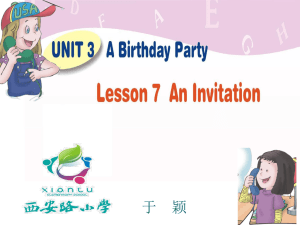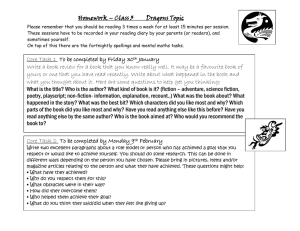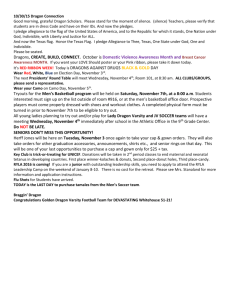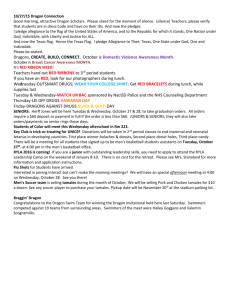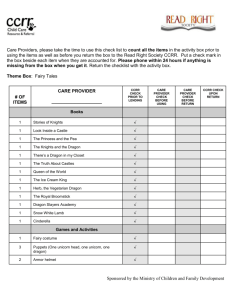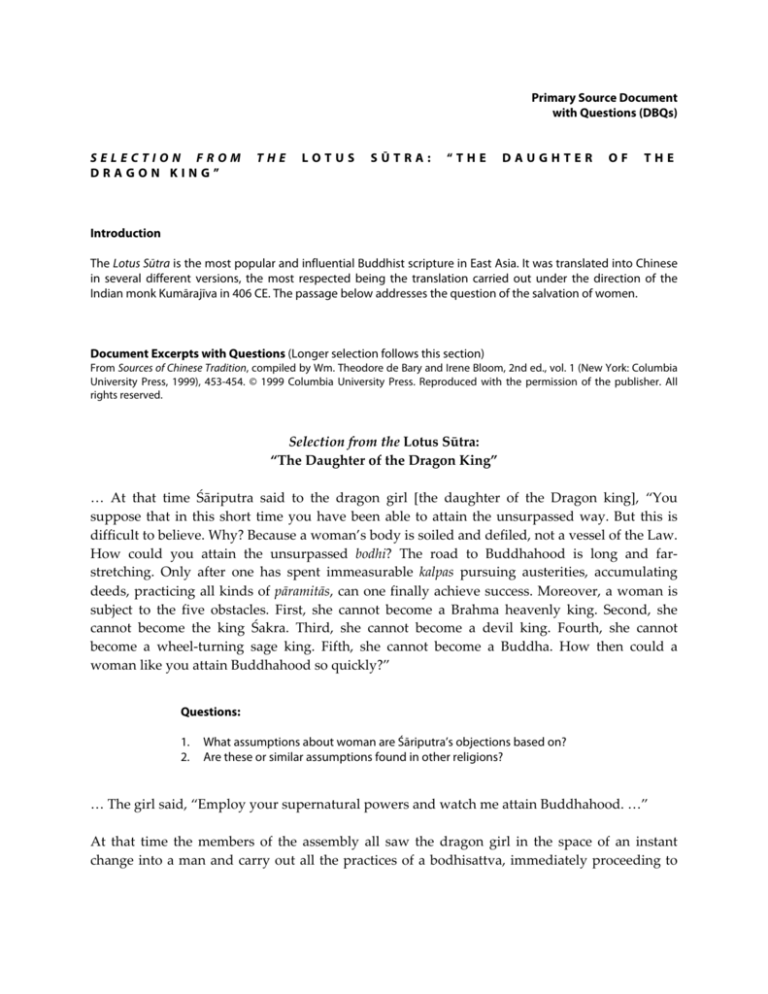
Primary Source Document
with Questions (DBQs)
SELECTION FROM
DRAGON KING”
THE
LOTUS
SŪTRA:
“THE
DAUGHTER
OF
THE
Introduction
The Lotus Sūtra is the most popular and influential Buddhist scripture in East Asia. It was translated into Chinese
in several different versions, the most respected being the translation carried out under the direction of the
Indian monk Kumārajīva in 406 CE. The passage below addresses the question of the salvation of women.
Document Excerpts with Questions (Longer selection follows this section)
From Sources of Chinese Tradition, compiled by Wm. Theodore de Bary and Irene Bloom, 2nd ed., vol. 1 (New York: Columbia
University Press, 1999), 453-454. © 1999 Columbia University Press. Reproduced with the permission of the publisher. All
rights reserved.
Selection
from
the
Lotus
Sūtra:
“The
Daughter
of
the
Dragon
King”
…
At
that
time
Śāriputra
said
to
the
dragon
girl
[the
daughter
of
the
Dragon
king],
“You
suppose
that
in
this
short
time
you
have
been
able
to
attain
the
unsurpassed
way.
But
this
is
difficult
to
believe.
Why?
Because
a
woman’s
body
is
soiled
and
defiled,
not
a
vessel
of
the
Law.
How
could
you
attain
the
unsurpassed
bodhi?
The
road
to
Buddhahood
is
long
and
far‑
stretching.
Only
after
one
has
spent
immeasurable
kalpas
pursuing
austerities,
accumulating
deeds,
practicing
all
kinds
of
pāramitās,
can
one
finally
achieve
success.
Moreover,
a
woman
is
subject
to
the
five
obstacles.
First,
she
cannot
become
a
Brahma
heavenly
king.
Second,
she
cannot
become
the
king
Śakra.
Third,
she
cannot
become
a
devil
king.
Fourth,
she
cannot
become
a
wheel‑turning
sage
king.
Fifth,
she
cannot
become
a
Buddha.
How
then
could
a
woman
like
you
attain
Buddhahood
so
quickly?”
Questions:
1.
2.
What assumptions about woman are Śāriputra’s objections based on?
Are these or similar assumptions found in other religions?
…
The
girl
said,
“Employ
your
supernatural
powers
and
watch
me
attain
Buddhahood.
…”
At
that
time
the
members
of
the
assembly
all
saw
the
dragon
girl
in
the
space
of
an
instant
change
into
a
man
and
carry
out
all
the
practices
of
a
bodhisattva,
immediately
proceeding
to
Primary Source Document, with Questions (DBQs) on
SELECTION FROM THE LOTUS SŪTRA: “THE DAUGHTER OF THE DRAGON KING”
the
Spotless
World
of
the
south,
taking
a
seat
on
the
jeweled
lotus,
and
attaining
impartial
and
correct
enlightenment.
…
Questions:
3.
4.
5.
How does the Dragon Girl refute Śāriputra’s arguments against her ability
to become enlightened quickly?
What Buddhist assumptions about the nature of reality is the story based
on?
Are you satisfied with the way in which the Dragon Girl refutes Śāriputra?
Why or why not?
Longer Selection
From Sources of Chinese Tradition, compiled by Wm. Theodore de Bary and Irene Bloom, 2nd ed., vol. 1 (New York: Columbia
University Press, 1999), 453-454. © 1999 Columbia University Press. Reproduced with the permission of the publisher. All
rights reserved.
Selection
from
the
Lotus
Sūtra:
“The
Daughter
of
the
Dragon
King”
Bodhisattva
Wisdom
Accumulated
questioned
Mañjuśrī,
saying,
“This
sūtra
is
very
profound,
subtle,
and
wonderful,
a
treasure
among
sūtras,
a
rarity
in
the
world.
Are
there
perhaps
any
living
beings
who,
by
earnestly
and
diligently
practicing
this
sūtra,
have
been
able
to
attain
Buddhahood
quickly?”
Mañjuśrī
replied,
“There
is
the
daughter
of
the
dragon
king
Sāgara,
who
has
just
turned
eight.
Her
wisdom
has
keen
roots,
and
she
is
good
at
understanding
the
root
activities
and
deeds
of
living
beings.
She
has
mastered
the
dhāranīs,
has
been
able
to
accept
and
embrace
all
the
storehouse
of
profound
secrets
preached
by
the
Buddhas,
has
entered
deep
into
meditation,
thoroughly
grasped
the
doctrines,
and
in
the
space
of
an
instant
conceived
the
desire
for
bodhi
and
reached
the
level
of
no
regression.
Her
eloquence
knows
no
hindrance,
and
she
thinks
of
living
beings
with
compassion
as
though
they
were
her
own
children.
She
is
fully
endowed
with
blessings,
and
when
it
comes
to
conceiving
in
mind
and
expounding
by
mouth,
she
is
subtle,
wonderful,
comprehensive,
and
great.
Kind,
compassionate,
benevolent,
yielding,
she
is
gentle
and
refined
in
will,
capable
of
attaining
bodhi.”
…
At
that
time
Śāriputra
said
to
the
dragon
girl,
“You
suppose
that
in
this
short
time
you
have
been
able
to
attain
the
unsurpassed
way.
But
this
is
difficult
to
believe.
Why?
Because
a
woman’s
body
is
soiled
and
defiled,
not
a
vessel
for
the
Law.
How
could
you
attain
the
unsurpassed
bodhi?
The
road
to
Buddhahood
is
long
and
far‑stretching.
Only
after
one
has
spent
immeasurable
kalpas
pursuing
austerities,
accumulating
deeds,
practicing
all
kinds
pāramitās,
can
one
finally
achieve
success.
Moreover,
a
woman
is
subject
to
the
five
obstacles.
Asia for Educators | Columbia University | http://afe.easia.columbia.edu
Page 2 of 3
Primary Source Document, with Questions (DBQs) on
SELECTION FROM THE LOTUS SŪTRA: “THE DAUGHTER OF THE DRAGON KING”
First,
she
cannot
become
a
Brahma
heavenly
king.
Second,
she
cannot
become
the
king
Śakra.
Third,
she
cannot
become
a
devil
king.
Fourth,
she
cannot
become
a
wheel‑turning
sage
king.
Fifth,
she
cannot
become
a
Buddha.
How
then
could
a
woman
like
you
be
able
to
attain
Buddhahood
so
quickly?”
At
that
time
the
dragon
girl
had
a
precious
jewel
worth
as
much
as
the
thousand‑millionfold
world,
which
she
presented
to
the
Buddha.
The
Buddha
immediately
accepted
it.
The
dragon
girl
said
to
Bodhisattva
Wisdom
Accumulated
and
to
the
venerable
one,
Śāriputra,
“I
presented
the
precious
jewel
and
the
World‑Honored
One
accepted
it
—
was
that
not
quickly
done?”
They
replied,
“Very
quickly!”
The
girl
said,
“Employ
your
supernatural
powers
and
watch
me
attain
Buddhahood.
It
will
be
even
quicker
than
that!”
At
that
time
the
members
of
the
assembly
all
saw
the
dragon
girl
in
the
space
of
an
instant
change
into
a
man
and
carry
out
all
the
practices
of
a
bodhisattva,
immediately
proceeding
to
the
Spotless
World
of
the
south,
taking
a
seat
on
a
jeweled
lotus,
and
attaining
impartial
and
correct
enlightenment.
With
the
thirty‑two
features
and
the
eighty
characteristics,
he
expounded
the
wonderful
Law
for
all
living
beings
everywhere
in
the
ten
directions.
…
Asia for Educators | Columbia University | http://afe.easia.columbia.edu
Page 3 of 3


